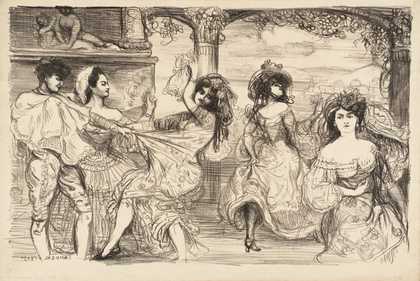Charles Conder was born in London in 1868; he was taken to India as a child, but was sent back to England in 1873 and went to school at Eastbourne.
At the age of 17 he joined an uncle in the Lands Department at Sydney, New South Wales, and obtained a post on the Illustrated Sydney News. He began to paint landscapes in 1886. Two years later he moved to Melbourne and studied at the National Gallery there, while teaching painting with Arthur Stretton.
In 1890 he returned to Europe and studied at Julian’s and the Louvre under Constant and Doucet. He was influenced by Toulouse-Lautrec and Anquetin and admired Puvis de Chavannes.
He was elected an Associate of the Société Nationale des Beaux-Arts and, in 1891, a Member of the New English Arts Club. In 1894 he was back in England and began to design fans. He held exhibitions of his work at the Carfax Gallery, 1900; the Leicester Galleries, 1901, 1905, 1913; the Dutch Gallery, 1913 and at Durand-Ruels in 1906. He also executed lithographs, the best being The Leaning Tree and The Balzac Set, 1899, and The Carnival Set of 1904.
His limited but exquisite art reveals an instinctive feeling for beauty, and lie is an example of the Petit Maitre, rare in English art. His untimely death in 1909 was an irreparable loss in view of his quite unusual gift for decoration and feeling for colour.



